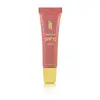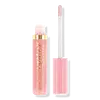What's inside
What's inside
 Key Ingredients
Key Ingredients

 Benefits
Benefits

 Concerns
Concerns

 Ingredients Side-by-side
Ingredients Side-by-side

Ethylhexyl Methoxycinnamate 7.5%
UV AbsorberBenzophenone-3 2%
UV AbsorberZinc Oxide 3%
Cosmetic ColorantPolybutene
Paraffinum Liquidum
EmollientOctyldodecanol
EmollientDiisostearyl Malate
EmollientBis-Diglyceryl Polyacyladipate-2
EmollientCaprylic/Capric Triglyceride
MaskingSilica Dimethyl Silylate
EmollientVp/Hexadecene Copolymer
Triacontanyl Pvp
HumectantMethyl Methacrylate Crosspolymer
Phytosteryl Macadamiate
Skin ConditioningButylene/Ethylene/Styrene Copolymer
Ethylene/Propylene/Styrene Copolymer
Phenoxyethanol
PreservativeSorbic Acid
PreservativeButyrospermum Parkii Butter
Skin ConditioningAroma
Hexadecene
SolventSodium Saccharin
MaskingTocopheryl Acetate
AntioxidantTin Oxide
AbrasiveTocopherol
AntioxidantGlycine Soja Oil
EmollientSilica
AbrasiveCI 75470
Cosmetic ColorantIron Oxides
CI 77492
Cosmetic ColorantCI 77499
Cosmetic ColorantMica
Cosmetic ColorantCI 73360
Cosmetic ColorantCI 15850
Cosmetic ColorantTitanium Dioxide
Cosmetic ColorantCI 19140
Cosmetic ColorantEthylhexyl Methoxycinnamate 7.5%, Benzophenone-3 2%, Zinc Oxide 3%, Polybutene, Paraffinum Liquidum, Octyldodecanol, Diisostearyl Malate, Bis-Diglyceryl Polyacyladipate-2, Caprylic/Capric Triglyceride, Silica Dimethyl Silylate, Vp/Hexadecene Copolymer, Triacontanyl Pvp, Methyl Methacrylate Crosspolymer, Phytosteryl Macadamiate, Butylene/Ethylene/Styrene Copolymer, Ethylene/Propylene/Styrene Copolymer, Phenoxyethanol, Sorbic Acid, Butyrospermum Parkii Butter, Aroma, Hexadecene, Sodium Saccharin, Tocopheryl Acetate, Tin Oxide, Tocopherol, Glycine Soja Oil, Silica, CI 75470, Iron Oxides, CI 77492, CI 77499, Mica, CI 73360, CI 15850, Titanium Dioxide, CI 19140
Petrolatum
EmollientPolyisobutene
Caprylic/Capric Triglyceride
MaskingPentaerythrityl Tetraisostearate
EmollientMethyl Methacrylate Crosspolymer
PEG-8 Beeswax
EmulsifyingSqualane
EmollientSilica
AbrasiveTribehenin
EmollientPhenoxyethanol
PreservativeTocopheryl Acetate
AntioxidantSimmondsia Chinensis Seed Oil
EmollientHelianthus Annuus Seed Oil
EmollientSalvia Hispanica Seed Oil
MoisturisingParfum
MaskingIsohexadecane
EmollientRetinyl Palmitate
Skin ConditioningBHT
AntioxidantEthylene/Propylene/Styrene Copolymer
Butylene/Ethylene/Styrene Copolymer
Sodium Hyaluronate
HumectantXanthan Gum
EmulsifyingTocopherol
AntioxidantTripeptide-1
Skin ConditioningBenzyl Benzoate
AntimicrobialCI 77891
Cosmetic ColorantIron Oxides
Petrolatum, Polyisobutene, Caprylic/Capric Triglyceride, Pentaerythrityl Tetraisostearate, Methyl Methacrylate Crosspolymer, PEG-8 Beeswax, Squalane, Silica, Tribehenin, Phenoxyethanol, Tocopheryl Acetate, Simmondsia Chinensis Seed Oil, Helianthus Annuus Seed Oil, Salvia Hispanica Seed Oil, Parfum, Isohexadecane, Retinyl Palmitate, BHT, Ethylene/Propylene/Styrene Copolymer, Butylene/Ethylene/Styrene Copolymer, Sodium Hyaluronate, Xanthan Gum, Tocopherol, Tripeptide-1, Benzyl Benzoate, CI 77891, Iron Oxides
Ingredients Explained
These ingredients are found in both products.
Ingredients higher up in an ingredient list are typically present in a larger amount.
We don't have a description for Butylene/Ethylene/Styrene Copolymer yet.
This ingredient is an emollient, solvent, and texture enhancer. It is considered a skin-softener by helping the skin prevent moisture loss.
It helps thicken a product's formula and makes it easier to spread by dissolving clumping compounds.
Caprylic Triglyceride is made by combining glycerin with coconut oil, forming a clear liquid.
While there is an assumption Caprylic Triglyceride can clog pores due to it being derived from coconut oil, there is no research supporting this.
Learn more about Caprylic/Capric TriglycerideWe don't have a description for Ethylene/Propylene/Styrene Copolymer yet.
This ingredient comes as a powder made up of small, porous, microbeads. It is used to add a silky feel to products and also helps absorb oil.
Phenoxyethanol is a preservative that has germicide, antimicrobial, and aromatic properties. Studies show that phenoxyethanol can prevent microbial growth. By itself, it has a scent that is similar to that of a rose.
It's often used in formulations along with Caprylyl Glycol to preserve the shelf life of products.
Silica, also known as silicon dioxide, is a naturally occurring mineral. It is used as a fine, spherical, and porous powder in cosmetics.
Though it has exfoliant properties, the function of silica varies depending on the product.
The unique structure of silica enhances the spreadability and adds smoothness, making it a great texture enhancer.
It is also used as an active carrier, emulsifier, and mattifier due to its ability to absorb excess oil.
In some products, tiny microneedles called spicules are made from silica or hydrolyzed sponge. When you rub them in, they lightly polish away dead skin layers and enhance the penetration of active ingredients.
Learn more about SilicaTocopherol (also known as Vitamin E) is a common antioxidant used to help protect the skin from free-radicals and strengthen the skin barrier. It's also fat soluble - this means our skin is great at absorbing it.
Vitamin E also helps keep your natural skin lipids healthy. Your lipid skin barrier naturally consists of lipids, ceramides, and fatty acids. Vitamin E offers extra protection for your skin’s lipid barrier, keeping your skin healthy and nourished.
Another benefit is a bit of UV protection. Vitamin E helps reduce the damage caused by UVB rays. (It should not replace your sunscreen). Combining it with Vitamin C can decrease sunburned cells and hyperpigmentation after UV exposure.
You might have noticed Vitamin E + C often paired together. This is because it is great at stabilizing Vitamin C. Using the two together helps increase the effectiveness of both ingredients.
There are often claims that Vitamin E can reduce/prevent scarring, but these claims haven't been confirmed by scientific research.
Learn more about TocopherolTocopheryl Acetate is AKA Vitamin E. It is an antioxidant and protects your skin from free radicals. Free radicals damage the skin by breaking down collagen.
One study found using Tocopheryl Acetate with Vitamin C decreased the number of sunburned cells.
Tocopheryl Acetate is commonly found in both skincare and dietary supplements.
Learn more about Tocopheryl AcetateThis ingredient is a combination of red, black, and yellow iron oxide pigments. This combination of colors is usually found in foundation, because it results in a "skin" color.